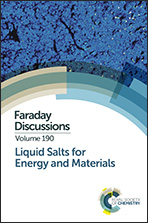Effect of C8mimPF6 on miniemulsion polymerization for application in new latex coating products
Abstract
C8mimPF6, as a type of room temperature ionic liquid (RTIL) with non-volatility and a low melting point, may replace conventional coalescing agents in latex coatings, thus preventing volatile organic compound (VOC) emissions caused by coalescing agents. In this study, systematic investigations on the effect of various factors including initiator type, initiator concentration, temperature and C8mimPF6 concentration on the conversion of latex and droplet/particle size of a miniemulsion during polymerization have been conducted. The presence of C8mimPF6 has shown to have a marked effect on the reaction rate. Such an effect strongly depends on the type of initiator being used. For polymerization initiated by 2,2-azobis (isobutyronitrile) (AIBN), C8mimPF6 had a promoting effect on the reaction rate at low concentrations, but this effect might be reversed upon certain C8mimPF6 concentrations, e.g. 10 wt%. While initiated by H2O2/Vc, this promoting effect faded even at low C8mimPF6 concentrations. The different limiting factors, which determine the reaction rate with different types of initiator, may contribute to the results. For reactions initiated by hydrophobic AIBN, the reaction was dominated by kinetics. The presence of C8mimPF6 may cause an enhanced chain propagation rate and reduced chain termination rate, which may further contribute to the increase in reaction rate at lower concentrations of C8mimPF6. With hydrophilic H2O2/Vc, the resistance for the transfer of radicals into a droplet/particle might be increased significantly with increasing C8mimPF6 concentration due to a tighter interfacial structure at lower concentrations of C8mimPF6. Thus, such transfer of radicals may become a limiting step whilst the presence of C8mimPF6 increases the transfer resistance on radicals resulting in a decrease in reaction rate. The reaction temperature, which is related to the decomposition temperature of the initiator being used, was another factor affecting the conversion of latex and the size of latex particles. A higher temperature e.g. 50 °C promotes the coalescence of droplets/particles, and hence produces larger latex particles. In the presence of C8mimPF6, the reaction temperature could be significantly reduced to as low as 40 °C, which prevents phase separation. The final particle size depends on the nucleation mechanism as well as the coalescence of droplets/particles during polymerization.
- This article is part of the themed collection: Liquid Salts for Energy and Materials

 Please wait while we load your content...
Please wait while we load your content...